Where Water Turns to Sand
An Arizona Wanderbout through the Lower Gila Sub-Basin
By Kris Reed
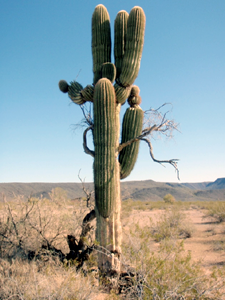
The January sun has reached its apex; to my northern blood, it feels like it's threatening to melt the lava rocks I'm meandering through. It's been awhile in coming since I left Yuma in Southwestern Arizona, but after seventy-five miles of walking, I'm finally in Saguaro country. The sentinels of the Sonoran desert bridge the gap between earth and sky and lift my footsteps in euphoric wandering, ecstatic at the presence of each plant and rock. Ocotillo! Hold tight your spears, there's a river to defend. Creosote, you are the Grandfather of this land, and your guidance is needed.
 My blood pulses with the phantom current of the Gila's long dry riverbed, and it's only ancient memories fueling it. The Gila River is dead, and in its dry sand strewn bed is the error in our ways; but in its resilient residents: the Mesquite, Seep Willow, Cottonwood, Peccary, Coyote, and the exiled Beaver, there is hope for their savior to be resurrected.
My blood pulses with the phantom current of the Gila's long dry riverbed, and it's only ancient memories fueling it. The Gila River is dead, and in its dry sand strewn bed is the error in our ways; but in its resilient residents: the Mesquite, Seep Willow, Cottonwood, Peccary, Coyote, and the exiled Beaver, there is hope for their savior to be resurrected.
The Gila River is several million years old, but ancestral rivers cut its path over 70 million years ago. The Gila gathers its strength along the Western slope of the Continental Divide in New Mexico. These Gila headwaters, known as the Upper Gila Sub-Basin, are the bosoming home to a diversity of peoples from the pre-Columbian farming peoples, the Mogollon, to the iconic hunter-gatherers of the Southwest, the Apache. It's the birthplace of Aldo Leopold's transformation and modern environmental philosophy.
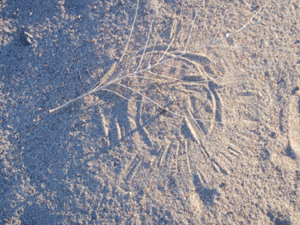 The Gila then flows through the homeland of a horticultural people known as Akimel O'odham and meets up with the Salt and Agua Fria rivers in Phoenix. The Akimel O'odham, the inheritors of the knowledge and land of the prehistoric Hohokam, have cultivated maize, beans, squash and cotton along the Gila since before the arrival of European peoples.
The Gila then flows through the homeland of a horticultural people known as Akimel O'odham and meets up with the Salt and Agua Fria rivers in Phoenix. The Akimel O'odham, the inheritors of the knowledge and land of the prehistoric Hohokam, have cultivated maize, beans, squash and cotton along the Gila since before the arrival of European peoples.
From Phoenix the mostly dry Gila "flows" through the Lower Gila Sub-Basin to its confluence with the Colorado River in Yuma, near the Mexico border, a distance of nearly two hundred miles. It is this portion that I walked during the course of ten days.
The Lower Gila Sub-Basin, before the arrival of the Spanish, was home to a group of peoples known collectively as the Patayan, and it is from the Yuman word Hah-quah-sa-eel, meaning "running river which is salty," that it is believed the Spanish contracted the river's contemporary name...Gila.
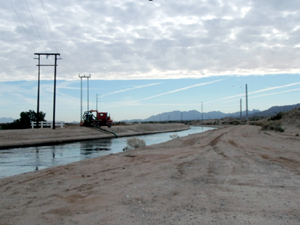 I start my walk just outside Yuma where highway 95 crosses over the Gila River. The sun is just now setting as I begin my journey east towards Phoenix, along the Gila, to learn what wisdom there is to glean from it. I'm surprised to find water in it, even though it is only a glorified puddle. I've been told the Gila is dead, and I want to know just what this means.
I start my walk just outside Yuma where highway 95 crosses over the Gila River. The sun is just now setting as I begin my journey east towards Phoenix, along the Gila, to learn what wisdom there is to glean from it. I'm surprised to find water in it, even though it is only a glorified puddle. I've been told the Gila is dead, and I want to know just what this means.
I'm drawn to this desiccated, forsaken ghost of a river for it is the Gila's heart and memories that reside in my chest and mind, and through my communion with the Gila I hope to understand my place, myself, my future. The Gila is my fetch, and if my ears are open, it can impart upon me knowledge of how I got here and what actions or non-actions I should take towards reconciliation with the abandonment of life and the puerilism of society. In the Gila I find comfort and companionship, and receive the strength to embrace the meaninglessness of my reality and flow with the rhythms of my soul.
I depart a Seep Willow thicket to find myself on a dirt road next to the Mohawk canal, which appears to be flowing upstream! The sun's dusky glow is rapidly leaving the sky when I make my camp under a Tamarisk and get my first taste of the Gila's water in a pot of rice and lentils.
The Gila's arteries are clogged with canals and dams, but I can feel the pulse of its primordial voice emanating from the bones of its Sonoran body. I fall asleep.
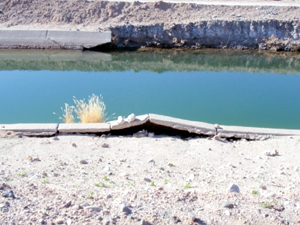 A shuffling noise brings me out of my cocoon, and my feet hit the dirt road anxious to know what bends this river will take. The Mohawk canal drags on, and I follow in hopes it will eventually lead me to the Gila River and not just its water. There is constant traffic of backhoes and dump trucks working to keep the Gila subdued under the fallacies of man's confidence as earth's shepherd and steward; but, the Gila knows its place and is trying to flow free. A railroad contours along the river, and I wander back and forth between it and the canal to see what plant life abounds; I am pleased to find flowers and greenery in the middle of winter!
A shuffling noise brings me out of my cocoon, and my feet hit the dirt road anxious to know what bends this river will take. The Mohawk canal drags on, and I follow in hopes it will eventually lead me to the Gila River and not just its water. There is constant traffic of backhoes and dump trucks working to keep the Gila subdued under the fallacies of man's confidence as earth's shepherd and steward; but, the Gila knows its place and is trying to flow free. A railroad contours along the river, and I wander back and forth between it and the canal to see what plant life abounds; I am pleased to find flowers and greenery in the middle of winter!
Land along the lower Gila is mostly public, administered by the Bureau of Land Management. Though I find no livestock until north of Painted Rock Reservoir, I do find an abundant flock of "snowbirds." Seemingly unsatisfied with how they've lived their lives to this point, they've decided to spend their remaining years exiled in the desert. They speed along on 4-wheelers with goggled eyes to keep their narrow view on life. They carve up any life they don't understand and rev their engines to drown out its screams...what a peculiar wisdom of our elders.
Just past interstate 8 I find a spot along the Gila canal to make camp and enjoy the heat of a Mesquite fire as night starts to cool towards freezing.
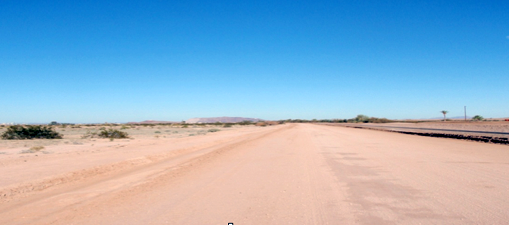 The Mohawk canal marches on doing no good to anyone. It is rapidly turning farmers' fields too salty to grow anything, especially crops unsuited to the desert. I run out of water, and it's time to drink the Gila. I worry about what agricultural poisons they may carry, but thirst is a bigger motivator. My first taste is not so pleasant, me finding the city water preferable (which is saying something in Arizona). I dial down the purification drops in later use, and it tastes fine.
The Mohawk canal marches on doing no good to anyone. It is rapidly turning farmers' fields too salty to grow anything, especially crops unsuited to the desert. I run out of water, and it's time to drink the Gila. I worry about what agricultural poisons they may carry, but thirst is a bigger motivator. My first taste is not so pleasant, me finding the city water preferable (which is saying something in Arizona). I dial down the purification drops in later use, and it tastes fine.
Mountain country is my home, and after awhile of walking in that varied terrain, you can look back to where you've come from and be proud of your accomplishment. But in this flat desert it seems I'm never moving forward. I was hoping to cover twenty miles a day along the canal, but I can't even manage fifteen! It appears I've fallen into my habitual ruts and weighted down my pack with too much food when the desert has plenty to provide, especially Palo Verde beans.
This evening while reaching for firewood, I realize my arm is on fire, and when my hand slaps fail to put it out, I must plunge my entire forearm into the sand. The sacrifices of two shirts teach me a valuable lesson unscathed: when petroleum is draped around you, karma will strike you with the same vengeance your kind uses to wrest the oil from its grave. May it rest in peace...
Honeybee boxes are now found every half mile along the canal. Their humming lullaby sings me to sleep.
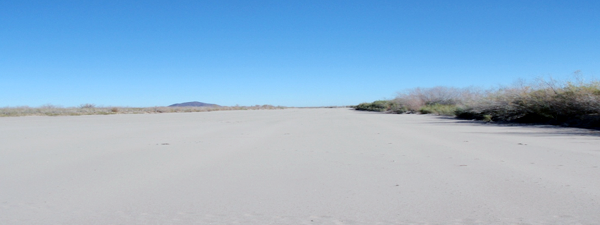 I'm struck by the fact that, outside of peoples' yards, there are no cacti in this part of the Sonoran; I mistakenly believed they'd be part of my vista every day. Outside of farm fields, this land is dominated by Saltbrush and Creosote, with Mesquite and Palo Verde located mostly around washes. The land turns from gravel to sand, and my bare feet are delighted. I errantly believe my legs, upon which pants seldom reside, have become sun burned. Thus I wear pants (with sunscreen underneath) the rest of the way until I realize it is not sunburn but rash, most likely from ag chemicals.
I'm struck by the fact that, outside of peoples' yards, there are no cacti in this part of the Sonoran; I mistakenly believed they'd be part of my vista every day. Outside of farm fields, this land is dominated by Saltbrush and Creosote, with Mesquite and Palo Verde located mostly around washes. The land turns from gravel to sand, and my bare feet are delighted. I errantly believe my legs, upon which pants seldom reside, have become sun burned. Thus I wear pants (with sunscreen underneath) the rest of the way until I realize it is not sunburn but rash, most likely from ag chemicals.
Coyote songs coax the moon closer to its term.
The canal ends...hurray! I meet two guys working on an irrigation ditch of a 7,000 acre farm. They kindly offer me cool, clean water and a lunch of steak fajitas...thanks! In conversation I ask where all this alfalfa goes, for I have seen no livestock or horses so far, and they inform me it gets shipped to China! We kill the Gila so China can feast upon the blood of this ancient river. If any religion, philosophy or morality would label something wrong, sinful and blasphemous, this is it! I thought the Gila was killed to feed the gluttonous desires of our palate, but lo, it's killed to feed the greed of our pocketbooks.
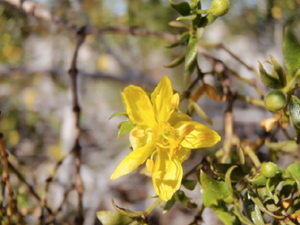 I bushwhack down a fifteen foot tall Mesquite brush pile, surprisingly picking up no scratches, and find myself on a vast sand desert. Wrongly presuming this to be the Private Airstrip that a sign said was ahead, I push on through the tangle of "riparian" brush in search of the Gila River. Cottonwoods, mostly dead, start to appear in the thicket, and I believe the river to be near. When I break back out onto the sand desert I realize this is the Gila! An eighth-mile wide winding strip of sand, that to all appearances is a beach and not a river...where's the water?
I bushwhack down a fifteen foot tall Mesquite brush pile, surprisingly picking up no scratches, and find myself on a vast sand desert. Wrongly presuming this to be the Private Airstrip that a sign said was ahead, I push on through the tangle of "riparian" brush in search of the Gila River. Cottonwoods, mostly dead, start to appear in the thicket, and I believe the river to be near. When I break back out onto the sand desert I realize this is the Gila! An eighth-mile wide winding strip of sand, that to all appearances is a beach and not a river...where's the water?
I start walking upstream, which one might find difficult to do if there were any water, and come upon water holes that are filled with Peccary and Coyote tracks. Having a quart in my too-heavy pack and finding these water holes with some regularity, I again prove myself ignorant to the extent this desert has been destroyed. I choose not to drink.
This vast sand beach clogs with the surrounding brush, and I question if I'm still heading up the main channel. The Gila begins to sing to me, and I jot down the lyrics of its song.
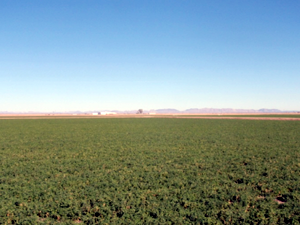 Gila...Gila...Gila...
Gila...Gila...Gila...
I walk your desert vain,
I feel your deserted pain.
And though your life may have been broken,
Of your grave we have yet spoken,
You lie where you lived.
My water is gone and I see no sign of my predicament improving. I'm ready to dig for water when I stumble upon a pig-water hole at least twelve feet deep! That's a lot of work for the tiny puddle that resides at the bottom. I may be a fool, but I know if Peccaries are going through that much effort to get water, then I better heed their warning and drink up. I crawl in headfirst, fearful of the looming sand cave that's encroaching over me, for as odd as it may seem, I do not wish to suffocate under twelve feet of sand! Luckily, I took Arizona's resident abo-dude Cody Lundin's advice and have a three foot flexible straw. I snake it down to the puddle and drink up. The water tastes quite ripe, but after that initial sip it goes down quite easily.
Dusk comes and finds me no closer to water. However, being waterless I decide I'd rather walk with the cool night air, than wait for the heat of tomorrow. Three hours into my night walk, I come upon the Avenue 64th bridge that crosses over the Gila. Confidant in my ability to roadwalk to town and water tomorrow, I thank the stars that guide me and go to sleep.
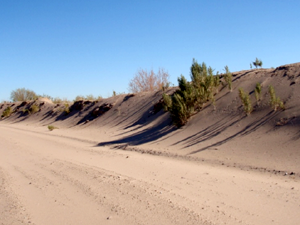 Without dinner or breakfast in my belly, I must temporarily leave the Gila and head towards the town of Hyder in search of water. I'm stopped by the U.S. Border Patrol and inaugurated to the power of invisible lines. I assure the agent that I am Captain America, and he lets me go on my way. Eight miles later I wander into a solar photovoltaic plant, and the guards kindly fill up all my water bottles.
Without dinner or breakfast in my belly, I must temporarily leave the Gila and head towards the town of Hyder in search of water. I'm stopped by the U.S. Border Patrol and inaugurated to the power of invisible lines. I assure the agent that I am Captain America, and he lets me go on my way. Eight miles later I wander into a solar photovoltaic plant, and the guards kindly fill up all my water bottles.
The solar plant is currently building a power line to Phoenix to provide its denizens with "seventeen megawatts of electricity, enough to power 4,000 homes," combat global warming and an energy-deficient future. It strikes me as odd how privileged, first-world citizens can only get stirred to action when the calamity is as distant, vague and abstract as global warming...all the while remaining blind to the dead rivers, species extinction, deforestation, biodiversity loss, overgrazing, erosion and farm field salinization and toxification in front of them. It seems to me that all the "solutions" to global warming are really solutions to grow the wallets of the rich and the population of the poor. Global warming is a symptom, not a problem, and will fade if the root issues are addressed properly. The cultures that persist into the future will have rediscovered mutually beneficial ways of inhabiting this planet...not having invented lifestyles that are just less damaging to it.
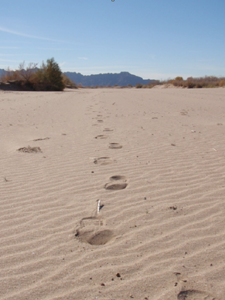 I arrive in Hyder and tank up for the night. A few miles out of town I see a humming bird with a red chest, and it strikes me how little wildlife, of all forms, I've actually seen on this trip. Nearly the only water source is the Gila and its tributaries. With it locked up in inaccessible canals this land cannot flourish. Their inaccessibility is easily demonstrated by the fact that I nearly fall into one trying to get water, and I've got hands!
I arrive in Hyder and tank up for the night. A few miles out of town I see a humming bird with a red chest, and it strikes me how little wildlife, of all forms, I've actually seen on this trip. Nearly the only water source is the Gila and its tributaries. With it locked up in inaccessible canals this land cannot flourish. Their inaccessibility is easily demonstrated by the fact that I nearly fall into one trying to get water, and I've got hands!
I find a wild honeybee hive under a railroad bridge and end up camping next to it after a midnight wind sends me scrambling for shelter.
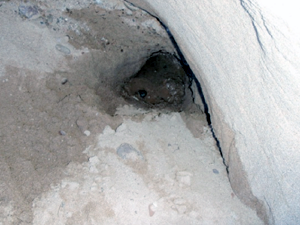 I walk towards the town of Montezuma and again validate my blundering fool persona when I realize that it is not a town but a locale (i.e. electrical transformer) and thus has no water...or halls. I am twenty miles from the mouth of Painted Rock Reservoir where I know (Ha!) I'll find water.
I walk towards the town of Montezuma and again validate my blundering fool persona when I realize that it is not a town but a locale (i.e. electrical transformer) and thus has no water...or halls. I am twenty miles from the mouth of Painted Rock Reservoir where I know (Ha!) I'll find water.
I walk along the train tracks, built in 1926, past an infinitely long train of boxcars. They've long since been abandoned to rust, and it makes me wonder how long the "achievements and progress" of our time - like the canals and photovoltaic power line - will last before they too are relinquished to Father Time. But hey, all the toil and misery are not in vain because we're trading the ampleness of tomorrow, for the intemperance of today.
I make the turn towards Painted Rock Reservoir and wander off trails of any sort. It's a lava rock domain and I am sent into rapture at the Saguaro country I've finally entered. Ocotillo, Cholla, Barrel and Christmas cactuses all finally appear! Elated, I doddle and wander for aimless hours.
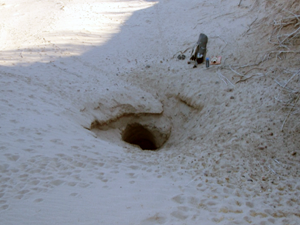 Back on the Gila River, I fill up a water bottle in a mud puddle. I spot Kill Deer foraging and realize the Gila has been relegated to deathly dams of waning life. I run awhile, fueled on beauty, and am but a mile from the dam when dusk leaves me to the moonlight. I look up at the immense dark void that is the Painted Rock Dam, erroneously built for flood control, and realize there is no way up to the water. I find no puddles below it either. The U.S. Army Corps of Engineers' administration compound (who built the dam in 1957-60) is secured behind padlocks and razor wire. Disheartened, my map shows that all trails and roads to the reservoir's water are well over twenty miles from where I stand. Not wanting to walk backwards a half dozen miles to the mud puddle, I decide to push ahead to some wells and springs that are a dozen or so miles into the Woolsey and Signal Mountain wildernesses.
Back on the Gila River, I fill up a water bottle in a mud puddle. I spot Kill Deer foraging and realize the Gila has been relegated to deathly dams of waning life. I run awhile, fueled on beauty, and am but a mile from the dam when dusk leaves me to the moonlight. I look up at the immense dark void that is the Painted Rock Dam, erroneously built for flood control, and realize there is no way up to the water. I find no puddles below it either. The U.S. Army Corps of Engineers' administration compound (who built the dam in 1957-60) is secured behind padlocks and razor wire. Disheartened, my map shows that all trails and roads to the reservoir's water are well over twenty miles from where I stand. Not wanting to walk backwards a half dozen miles to the mud puddle, I decide to push ahead to some wells and springs that are a dozen or so miles into the Woolsey and Signal Mountain wildernesses.
With previous "knowledge and certainty" that I was but an hour from water, I finished every last drop I had on me. No reason to despair though...for the moon is full and night walking is a true joy of life. As I wander along, I thank all the inhabitants of this domain, from the melanic rocks to the effervescent stars. Their presence and gifts bring me closer to my acquiescence.
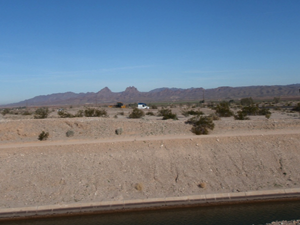 I arrive at an ingenious rain water catchment device. The water is more algae and dead bugs than liquid, but I am extremely happy with it, for it is past midnight, and I am more than ready for sleep.
I arrive at an ingenious rain water catchment device. The water is more algae and dead bugs than liquid, but I am extremely happy with it, for it is past midnight, and I am more than ready for sleep.
I am too sore to move much and with good reason. Yesterday I walked FORTY miles! It is by far the most I've ever done. I spend the day cooking and sunbathing, then hike and hitch to Phoenix in the following days.
Not much else to report, but this place is awesome! To all the locals, come check it out, and get out and walk around. And to the more distant citizens of America, if you come in search of mighty rivers, the manicured and comely appearance of National Parks, and the untamed majesty of our Wilderness areas...you'll be hard-pressed to find it.
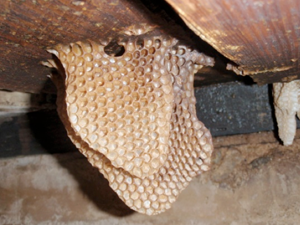 Our insistence that all lands should appear as our ancestral homeland in Europe with its moderate climate, consistent rainfall, and vast stretches of lawn have driven us to colonize, dam, divert, and suck dry the lifeblood of this land so we can have tropical fruits and golf courses in the desert. Our conviction in manifest destiny and the biblical demand to "subdue and have dominion over the earth and every living thing upon it" and Brigham Young's "make the deserts bloom," have driven the construction of cities like Phoenix, Yuma, and Tucson. They make putrid what was once sweet by their refusal to be guided by the heartbeats of this land. The real monster of the Gila is not a lizard holdover from temperate times, but us.
Our insistence that all lands should appear as our ancestral homeland in Europe with its moderate climate, consistent rainfall, and vast stretches of lawn have driven us to colonize, dam, divert, and suck dry the lifeblood of this land so we can have tropical fruits and golf courses in the desert. Our conviction in manifest destiny and the biblical demand to "subdue and have dominion over the earth and every living thing upon it" and Brigham Young's "make the deserts bloom," have driven the construction of cities like Phoenix, Yuma, and Tucson. They make putrid what was once sweet by their refusal to be guided by the heartbeats of this land. The real monster of the Gila is not a lizard holdover from temperate times, but us.
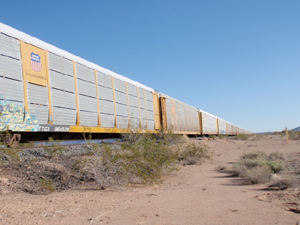 So if you wish to travel the Gila, shed your realities...if you come from the East, this land has no water; if ye arrive from the North, this land has no soil. It can show you your fate if you disregard the teachings of your patch of Earth, and it can receive your blessings if you come with an empty heart and mind.
So if you wish to travel the Gila, shed your realities...if you come from the East, this land has no water; if ye arrive from the North, this land has no soil. It can show you your fate if you disregard the teachings of your patch of Earth, and it can receive your blessings if you come with an empty heart and mind.
The Gila is a mother of life that has been beaten, cut, and raped into submission, but she will not conform. She has proven herself to be a coiled spring, ready to retake her birthright when we are ready to step out of the way and walk with the rhythms of the desert. When we put our faith and trust in the Gila instead of our inventions, then we'll find that Eden has reemerged on Earth.
Kris Reed is a part-time instructor at Green University® LLC
Return to Kris Reed Adventure Journals




 Primitive Living Skills
Primitive Living Skills


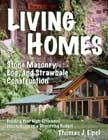




 My blood pulses with the phantom current of the Gila's long dry riverbed, and it's only ancient memories fueling it. The Gila River is dead, and in its dry sand strewn bed is the error in our ways; but in its resilient residents: the Mesquite, Seep Willow, Cottonwood, Peccary, Coyote, and the exiled Beaver, there is hope for their savior to be resurrected.
My blood pulses with the phantom current of the Gila's long dry riverbed, and it's only ancient memories fueling it. The Gila River is dead, and in its dry sand strewn bed is the error in our ways; but in its resilient residents: the Mesquite, Seep Willow, Cottonwood, Peccary, Coyote, and the exiled Beaver, there is hope for their savior to be resurrected.  The Gila then flows through the homeland of a horticultural people known as Akimel O'odham and meets up with the Salt and Agua Fria rivers in Phoenix. The Akimel O'odham, the inheritors of the knowledge and land of the prehistoric Hohokam, have cultivated maize, beans, squash and cotton along the Gila since before the arrival of European peoples.
The Gila then flows through the homeland of a horticultural people known as Akimel O'odham and meets up with the Salt and Agua Fria rivers in Phoenix. The Akimel O'odham, the inheritors of the knowledge and land of the prehistoric Hohokam, have cultivated maize, beans, squash and cotton along the Gila since before the arrival of European peoples.  I start my walk just outside Yuma where highway 95 crosses over the Gila River. The sun is just now setting as I begin my journey east towards Phoenix, along the Gila, to learn what wisdom there is to glean from it. I'm surprised to find water in it, even though it is only a glorified puddle. I've been told the Gila is dead, and I want to know just what this means.
I start my walk just outside Yuma where highway 95 crosses over the Gila River. The sun is just now setting as I begin my journey east towards Phoenix, along the Gila, to learn what wisdom there is to glean from it. I'm surprised to find water in it, even though it is only a glorified puddle. I've been told the Gila is dead, and I want to know just what this means.  A shuffling noise brings me out of my cocoon, and my feet hit the dirt road anxious to know what bends this river will take. The Mohawk canal drags on, and I follow in hopes it will eventually lead me to the Gila River and not just its water. There is constant traffic of backhoes and dump trucks working to keep the Gila subdued under the fallacies of man's confidence as earth's shepherd and steward; but, the Gila knows its place and is trying to flow free. A railroad contours along the river, and I wander back and forth between it and the canal to see what plant life abounds; I am pleased to find flowers and greenery in the middle of winter!
A shuffling noise brings me out of my cocoon, and my feet hit the dirt road anxious to know what bends this river will take. The Mohawk canal drags on, and I follow in hopes it will eventually lead me to the Gila River and not just its water. There is constant traffic of backhoes and dump trucks working to keep the Gila subdued under the fallacies of man's confidence as earth's shepherd and steward; but, the Gila knows its place and is trying to flow free. A railroad contours along the river, and I wander back and forth between it and the canal to see what plant life abounds; I am pleased to find flowers and greenery in the middle of winter!  The Mohawk canal marches on doing no good to anyone. It is rapidly turning farmers' fields too salty to grow anything, especially crops unsuited to the desert. I run out of water, and it's time to drink the Gila. I worry about what agricultural poisons they may carry, but thirst is a bigger motivator. My first taste is not so pleasant, me finding the city water preferable (which is saying something in Arizona). I dial down the purification drops in later use, and it tastes fine.
The Mohawk canal marches on doing no good to anyone. It is rapidly turning farmers' fields too salty to grow anything, especially crops unsuited to the desert. I run out of water, and it's time to drink the Gila. I worry about what agricultural poisons they may carry, but thirst is a bigger motivator. My first taste is not so pleasant, me finding the city water preferable (which is saying something in Arizona). I dial down the purification drops in later use, and it tastes fine.  I'm struck by the fact that, outside of peoples' yards, there are no cacti in this part of the Sonoran; I mistakenly believed they'd be part of my vista every day. Outside of farm fields, this land is dominated by Saltbrush and Creosote, with Mesquite and Palo Verde located mostly around washes. The land turns from gravel to sand, and my bare feet are delighted. I errantly believe my legs, upon which pants seldom reside, have become sun burned. Thus I wear pants (with sunscreen underneath) the rest of the way until I realize it is not sunburn but rash, most likely from ag chemicals.
I'm struck by the fact that, outside of peoples' yards, there are no cacti in this part of the Sonoran; I mistakenly believed they'd be part of my vista every day. Outside of farm fields, this land is dominated by Saltbrush and Creosote, with Mesquite and Palo Verde located mostly around washes. The land turns from gravel to sand, and my bare feet are delighted. I errantly believe my legs, upon which pants seldom reside, have become sun burned. Thus I wear pants (with sunscreen underneath) the rest of the way until I realize it is not sunburn but rash, most likely from ag chemicals.  I bushwhack down a fifteen foot tall Mesquite brush pile, surprisingly picking up no scratches, and find myself on a vast sand desert. Wrongly presuming this to be the Private Airstrip that a sign said was ahead, I push on through the tangle of "riparian" brush in search of the Gila River. Cottonwoods, mostly dead, start to appear in the thicket, and I believe the river to be near. When I break back out onto the sand desert I realize this is the Gila! An eighth-mile wide winding strip of sand, that to all appearances is a beach and not a river...where's the water?
I bushwhack down a fifteen foot tall Mesquite brush pile, surprisingly picking up no scratches, and find myself on a vast sand desert. Wrongly presuming this to be the Private Airstrip that a sign said was ahead, I push on through the tangle of "riparian" brush in search of the Gila River. Cottonwoods, mostly dead, start to appear in the thicket, and I believe the river to be near. When I break back out onto the sand desert I realize this is the Gila! An eighth-mile wide winding strip of sand, that to all appearances is a beach and not a river...where's the water?  Gila...Gila...Gila...
Gila...Gila...Gila... Without dinner or breakfast in my belly, I must temporarily leave the Gila and head towards the town of Hyder in search of water. I'm stopped by the U.S. Border Patrol and inaugurated to the power of invisible lines. I assure the agent that I am Captain America, and he lets me go on my way. Eight miles later I wander into a solar photovoltaic plant, and the guards kindly fill up all my water bottles.
Without dinner or breakfast in my belly, I must temporarily leave the Gila and head towards the town of Hyder in search of water. I'm stopped by the U.S. Border Patrol and inaugurated to the power of invisible lines. I assure the agent that I am Captain America, and he lets me go on my way. Eight miles later I wander into a solar photovoltaic plant, and the guards kindly fill up all my water bottles.  I arrive in Hyder and tank up for the night. A few miles out of town I see a humming bird with a red chest, and it strikes me how little wildlife, of all forms, I've actually seen on this trip. Nearly the only water source is the Gila and its tributaries. With it locked up in inaccessible canals this land cannot flourish. Their inaccessibility is easily demonstrated by the fact that I nearly fall into one trying to get water, and I've got hands!
I arrive in Hyder and tank up for the night. A few miles out of town I see a humming bird with a red chest, and it strikes me how little wildlife, of all forms, I've actually seen on this trip. Nearly the only water source is the Gila and its tributaries. With it locked up in inaccessible canals this land cannot flourish. Their inaccessibility is easily demonstrated by the fact that I nearly fall into one trying to get water, and I've got hands!  I walk towards the town of Montezuma and again validate my blundering fool persona when I realize that it is not a town but a locale (i.e. electrical transformer) and thus has no water...or halls. I am twenty miles from the mouth of Painted Rock Reservoir where I know (Ha!) I'll find water.
I walk towards the town of Montezuma and again validate my blundering fool persona when I realize that it is not a town but a locale (i.e. electrical transformer) and thus has no water...or halls. I am twenty miles from the mouth of Painted Rock Reservoir where I know (Ha!) I'll find water.  Back on the Gila River, I fill up a water bottle in a mud puddle. I spot Kill Deer foraging and realize the Gila has been relegated to deathly dams of waning life. I run awhile, fueled on beauty, and am but a mile from the dam when dusk leaves me to the moonlight. I look up at the immense dark void that is the Painted Rock Dam, erroneously built for flood control, and realize there is no way up to the water. I find no puddles below it either. The U.S. Army Corps of Engineers' administration compound (who built the dam in 1957-60) is secured behind padlocks and razor wire. Disheartened, my map shows that all trails and roads to the reservoir's water are well over twenty miles from where I stand. Not wanting to walk backwards a half dozen miles to the mud puddle, I decide to push ahead to some wells and springs that are a dozen or so miles into the Woolsey and Signal Mountain wildernesses.
Back on the Gila River, I fill up a water bottle in a mud puddle. I spot Kill Deer foraging and realize the Gila has been relegated to deathly dams of waning life. I run awhile, fueled on beauty, and am but a mile from the dam when dusk leaves me to the moonlight. I look up at the immense dark void that is the Painted Rock Dam, erroneously built for flood control, and realize there is no way up to the water. I find no puddles below it either. The U.S. Army Corps of Engineers' administration compound (who built the dam in 1957-60) is secured behind padlocks and razor wire. Disheartened, my map shows that all trails and roads to the reservoir's water are well over twenty miles from where I stand. Not wanting to walk backwards a half dozen miles to the mud puddle, I decide to push ahead to some wells and springs that are a dozen or so miles into the Woolsey and Signal Mountain wildernesses.  I arrive at an ingenious rain water catchment device. The water is more algae and dead bugs than liquid, but I am extremely happy with it, for it is past midnight, and I am more than ready for sleep.
I arrive at an ingenious rain water catchment device. The water is more algae and dead bugs than liquid, but I am extremely happy with it, for it is past midnight, and I am more than ready for sleep.  Our insistence that all lands should appear as our ancestral homeland in Europe with its moderate climate, consistent rainfall, and vast stretches of lawn have driven us to colonize, dam, divert, and suck dry the lifeblood of this land so we can have tropical fruits and golf courses in the desert. Our conviction in manifest destiny and the biblical demand to "subdue and have dominion over the earth and every living thing upon it" and Brigham Young's "make the deserts bloom," have driven the construction of cities like Phoenix, Yuma, and Tucson. They make putrid what was once sweet by their refusal to be guided by the heartbeats of this land. The real monster of the Gila is not a lizard holdover from temperate times, but us.
Our insistence that all lands should appear as our ancestral homeland in Europe with its moderate climate, consistent rainfall, and vast stretches of lawn have driven us to colonize, dam, divert, and suck dry the lifeblood of this land so we can have tropical fruits and golf courses in the desert. Our conviction in manifest destiny and the biblical demand to "subdue and have dominion over the earth and every living thing upon it" and Brigham Young's "make the deserts bloom," have driven the construction of cities like Phoenix, Yuma, and Tucson. They make putrid what was once sweet by their refusal to be guided by the heartbeats of this land. The real monster of the Gila is not a lizard holdover from temperate times, but us.  So if you wish to travel the Gila, shed your realities...if you come from the East, this land has no water; if ye arrive from the North, this land has no soil. It can show you your fate if you disregard the teachings of your patch of Earth, and it can receive your blessings if you come with an empty heart and mind.
So if you wish to travel the Gila, shed your realities...if you come from the East, this land has no water; if ye arrive from the North, this land has no soil. It can show you your fate if you disregard the teachings of your patch of Earth, and it can receive your blessings if you come with an empty heart and mind.